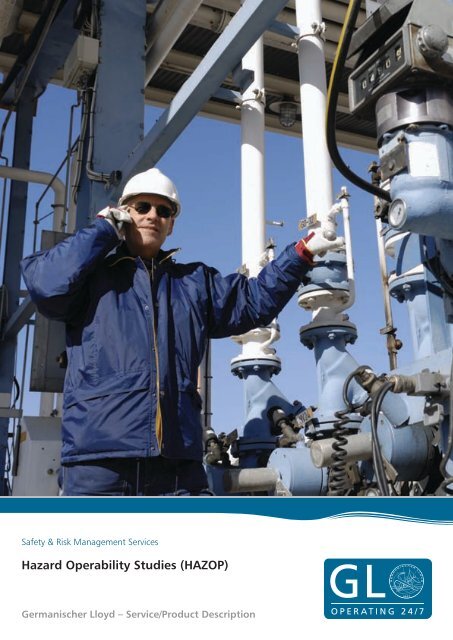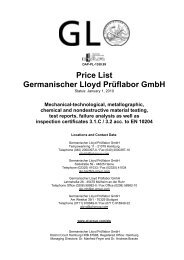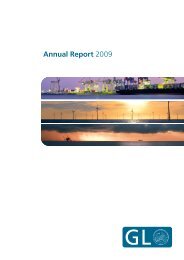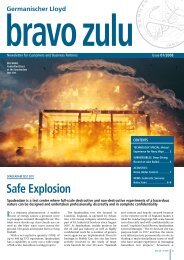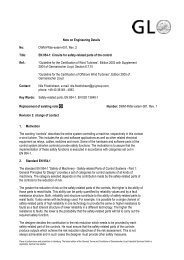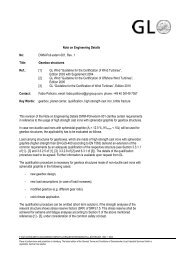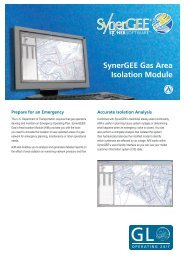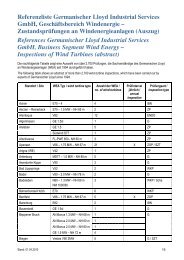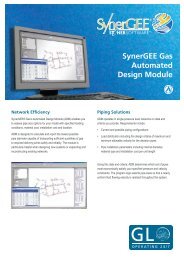Hazard Operability Studies (HAZOP) - GL Noble Denton
Hazard Operability Studies (HAZOP) - GL Noble Denton
Hazard Operability Studies (HAZOP) - GL Noble Denton
Create successful ePaper yourself
Turn your PDF publications into a flip-book with our unique Google optimized e-Paper software.
Safety & Risk Management Services<br />
<strong>Hazard</strong> <strong>Operability</strong> <strong>Studies</strong> (<strong>HAZOP</strong>)<br />
Germanischer Lloyd – Service/Product Description
<strong>Hazard</strong> <strong>Operability</strong> <strong>Studies</strong><br />
(<strong>HAZOP</strong>)<br />
2<br />
Germanischer Lloyd – Service/Product Description<br />
Service Title: Safety & Risk Management Services<br />
Lead Practice: <strong>GL</strong> Safety & Risk (UK)<br />
Page 3<br />
Pages 4 - 6<br />
Page 7<br />
a:<br />
Contents<br />
Service Description and Values Generated<br />
Detailed Method Statement<br />
The detailed method statements explain how the<br />
work is conducted, which inputs are required and<br />
which outputs and results can be expected.<br />
Case <strong>Studies</strong> and Examples<br />
Natural Gas Cavern Storage
Service Description<br />
and Values Generated:<br />
Motivation<br />
The hazard and operability study (<strong>HAZOP</strong>) is a creative technique for<br />
identifying hazards and operating problems in a process plant.<br />
Nowadays it is widely used in industry and is offered by Germanischer<br />
Lloyd (<strong>GL</strong>) for new and existing facilities.<br />
Increasing demand by governments and public bodies for improved<br />
safety in addition to a strong awareness within the industry that safe<br />
operation can also be highly efficient and profitable, support the need<br />
for plant safety and effective safety management. Advances in technology<br />
and trends to highly complex and integrated plant designs<br />
have sensitised people for systematic and sustainable methods to<br />
identify hazards of which the <strong>HAZOP</strong> study is generally recognised as<br />
the foremost solution being able to cover standard and also new<br />
complex technology.<br />
The operator of a technical installation by which health and safety,<br />
the environment, assets and the operator’s reputation could be<br />
affected is obliged e.g. by European legislation to:<br />
have an up-to-date knowledge about all safety relevant<br />
aspects of their operations,<br />
prevent accidents or to limit their impacts/escalations<br />
(acc. to Seveso II Directive),<br />
control hazards reliably and to minimise risks by<br />
identifying installations with risk potential regarding<br />
health and safety as well as the environment, evaluating<br />
their inherent risks and specifying risk mitigation<br />
measures (which is part of the risk management process),<br />
design, start up, operate and maintain workplaces in such<br />
a manner that the workforce can conduct work without<br />
putting their own safety and health or that of others at<br />
risk (§2 Abs.l Allg. Bundesbergverordnung ABBergV, §3<br />
ArbSchG)<br />
Objectives<br />
The primary objective of a <strong>HAZOP</strong> study is to identify potential hazards<br />
and operating problems on e.g. a process plant. Performed by a<br />
multi-disciplinary team which applies the <strong>HAZOP</strong> structured<br />
brainstorming technique all possible deviations from normal<br />
operating conditions are examined in detail and their reasons and<br />
consequences are assessed. The detailed insight into the plant is<br />
supported by dividing the plant into manageable sections, so called<br />
'nodes'. Specific 'parameters' and 'guidewords' are used to focus the<br />
team towards likely design issues in each section of the plant. Once<br />
identified, potential 'deviations' from the standard operating or design<br />
conditions may then be discussed and assessed by the team with<br />
respect to their effect on safety. Subsequently the implemented<br />
safeguards are identified and where considered necessary<br />
recommendations for action or further consideration are recorded<br />
and presented in the form of the <strong>HAZOP</strong> Report. The necessity of<br />
additional safeguards/recommendations can either be evaluated by<br />
the team on a qualitative basis or by means of a risk matrix.<br />
<strong>HAZOP</strong> studies may be held at any time during the design and<br />
operation of a plant. Most effectively they are conducted during the<br />
conceptual design phase where recommendations affecting the<br />
general design may be made.<br />
The analysis serves the operator as a proof to operate his installations<br />
such that hazards for employees, third parties, the environment and<br />
the surroundings can largely be excluded. The operator’s<br />
management gets an up-to-date picture of the present hazards, their<br />
possible effects and ways to solve these issues.<br />
Frequency of Reviews<br />
<strong>HAZOP</strong> analyses are usually to be revised when considerable<br />
modifications, upgrades or re-design of existing facilities are carried<br />
out or if events like accidents, critical situations or near misses call for<br />
this. In this context a change, upgrade or re-design is to be considered<br />
as essential if process modifications associated with consequences for<br />
safety or safety related equipment is involved. This also applies for<br />
utilities including buildings, machinery, equipment et al. that do not<br />
necessarily contribute to the operating objective directly but that are<br />
associated with the process facilities in terms of layout or operationalwise<br />
and that are safety relevant. Those being in charge of operations<br />
and those working in the facilities are obliged to indicate all identified<br />
possible changes. In principle operators are expected to repeat the<br />
analyses at least every 5 years in order to maintain the residual risk as<br />
low as reasonable practical.<br />
Offered Service<br />
The success of the <strong>HAZOP</strong> technique strongly depends on the skills<br />
and experience of the facilitator in preparing and running the study.<br />
A sufficient depth to derive all the potential hazards and safety related<br />
operability problems and on the other hand the avoidance of a time<br />
consuming design review which is out of scope for a <strong>HAZOP</strong> are<br />
essential for the effectiveness and quality of the sessions. The service<br />
offered in this matter is the provision of an experienced facilitator<br />
/chairman that leads through the <strong>HAZOP</strong> sessions supported by an<br />
experienced minute taker/scribe who notes down the relevant results<br />
into the prepared <strong>HAZOP</strong> spreadsheet. Depending on clients’ needs<br />
in house spreadsheets or a special <strong>HAZOP</strong> software tool will be used<br />
by the <strong>HAZOP</strong> management team. Subsequently upon completion of<br />
the sessions a report will be prepared by the <strong>HAZOP</strong> chairman and<br />
submitted to the client.<br />
Potential Clients<br />
SERVICE DESCRIPTION<br />
a. Operators in the oil, gas and (petro-, bio-) chemical<br />
business carrying out green-field and brown-field<br />
projects. The service can be rendered beginning in the<br />
FEED stage of a project.<br />
b. Investors, insurers of above named enterprises<br />
3
4<br />
DETAILED METHOD STATEMENT<br />
The success of the <strong>HAZOP</strong> study depends upon an effective system<br />
for working through the items of the study. Germanischer Lloyd<br />
provides this effective system through the experience gained from<br />
several <strong>HAZOP</strong> studies and the theoretical and practical departmental<br />
expertise.<br />
As a first step, the definition of scope is considered with respect to the<br />
special requirements of the client before the required data are<br />
collected by the <strong>HAZOP</strong> team and/or <strong>HAZOP</strong> facilitator. The plant or<br />
process under investigation is divided into a number of suitable units,<br />
the <strong>HAZOP</strong> nodes. Each node is the topic of a <strong>HAZOP</strong> session,<br />
conducted under the supervision of a <strong>GL</strong> team leader/facilitator who<br />
is an expert in the <strong>HAZOP</strong> technique. <strong>GL</strong> will also provide an<br />
experienced minute taker/scribe to assist the facilitator by entering<br />
the team’s brain-storming outcomes into the spreadsheets/software<br />
during the ongoing discussions. Each <strong>HAZOP</strong> session takes 1 ½ … 3<br />
hours, depending on the scope of the item under discussion and on<br />
the plant or process itself – new or existing. A <strong>HAZOP</strong> on a large<br />
project may consist of a large number of nodes and respectively<br />
require several weeks to be performed.<br />
<strong>HAZOP</strong> technique assumes that the plant management is competent<br />
and that the plant or process under investigation will be operated<br />
and maintained as intended by the design team and in accordance<br />
with good management and engineering practice.<br />
The <strong>HAZOP</strong> study starts with a systematic examination of the plant or<br />
process with a depth depending on the level of detail required.<br />
A list of guide words is applied to each part of the plant or process,<br />
thereby generating deviations from normal operating conditions with<br />
respect to all conceivable eventualities. Apart from normal operations<br />
the following are considered and listed for all guidewords of each<br />
<strong>HAZOP</strong>: foreseeable changes to start-up and shut-down procedures,<br />
maintenance, etc. Each deviation is checked for possible causes and<br />
consequences; potential problems are identified and noted, and the<br />
need for action is decided by taking into account both the significance<br />
of the consequence(s) and the probability of the event occurring.<br />
If necessary, a team member explains the function of the item under<br />
investigation, including normal process conditions and specifications<br />
if available, to ensure that all team members have the background<br />
knowledge of the item examined.<br />
In general to search for possible deviations each <strong>HAZOP</strong> item is<br />
examined by applying the guide words<br />
NONE<br />
REVERSE<br />
MORE OF<br />
LESS OF<br />
PART OF<br />
MORE THAN<br />
OTHER THAN<br />
Depending on the item, the following deviations may be considered.<br />
The item under investigation, e.g. a flow, is examined by applying the<br />
guide words, e.g. MORE OF. As a first step, possible causes for "more<br />
flow" (deviation from normal forward flow) are considered. If "more<br />
flow" is not possible, the team leader/<strong>HAZOP</strong> team moves on to the<br />
next deviation. If "more flow" is possible, but does not prevent<br />
efficient operation (and is considered not to affect safety), other<br />
causes of "more flow" are to be considered. If a possible cause can<br />
lead to hazardous situation(s), further consequences (detection of the<br />
deviation, change in plant or method to prevent "more flow", etc.) are<br />
discussed and action(s) required are noted and/or suggested to the<br />
client. Protection against the consequences can be achieved by<br />
changing the plant design and/or operation method.
By defining appropriate nodes, each system or equipment is divided<br />
into sub-systems by consensus of the review team. The selected<br />
system is identified by a study node number and for easy reference a<br />
colour code can also be applied on the related P&IDs prior to the<br />
review and worksheet during the review.<br />
The <strong>HAZOP</strong> process should proceed as follows:<br />
1. Select the appropriate node<br />
2. Apply the first or next parameter<br />
3. Apply the first or next guideword, which in combination<br />
with the parameter gives the deviation<br />
4. Determine deviation<br />
5. Identify all potential causes of the deviation<br />
6. Appraise the consequences of the deviation<br />
7. Appraise the safeguards preventing or mitigating the<br />
deviation and its consequences<br />
8. Agree a recommendation for action or further<br />
consideration of the problem where required<br />
9. Once all causes and consequences for a given deviation<br />
have been identified and the requirement for action<br />
discussed, the procedure returns to step 3. This process<br />
iterates until all guidewords have been combined with a<br />
selected parameter.<br />
10.Once all guidewords have been considered the next the<br />
next parameter will be selected (step 2) and the process<br />
will be repeated until all parameters have been applied<br />
11.Then the discussion moves to the next node and the<br />
process will be repeated until all nodes are applied.<br />
As mentioned above the <strong>HAZOP</strong> also includes the division of the plant<br />
into sections/nodes.<br />
DETAILED METHOD STATEMENT<br />
The method consists of a systematic study of all process and utility<br />
lines and equipment included in the project. The study will primarily<br />
be performed based on the piping and instrumentation diagrams<br />
(P&IDs) developed for the project. The study will be confined within<br />
the new and modified facilities only, along with tie-ins with the<br />
existing.<br />
Each line will be studied as a whole from battery limit to battery limit<br />
or to the equipment connected to the end of the line, whichever<br />
applicable.<br />
For each line, the study will look at the appropriate process<br />
parameters and the key word as listed on the following table:<br />
5
DETAILED METHOD STATEMENT<br />
For each key word, the <strong>HAZOP</strong> team will list the possible causes and<br />
the consequences regarding the operating procedures and the safety<br />
aspects from both personnel and material point of view. If the<br />
consequences are considered as being out of the normal operating<br />
range, the <strong>HAZOP</strong> team will investigate the installed safeguards:<br />
a) The detection devices, to ensure that the operator will be<br />
aware that something abnormal is happening.<br />
b) The safety devices installed, to limit the consequences of<br />
the process upset. If the P&ID shows devices which are<br />
considered adequate for the considered risk, the next key<br />
word will be reviewed, then the next parameter, then the<br />
next process lines or equipment.<br />
Key aspects may include:<br />
a) A detailed systematic study of the design and outline<br />
operating and maintenance philosophy to identify the<br />
consequences from design intent.<br />
b) Consideration of transient operating conditions during<br />
start-up, shut-down, plant upsets and emergencies.<br />
c) Consideration of potential exposure of employees to<br />
chemicals during routine operations including<br />
maintenance, de-contamination, etc. If the protection by<br />
so called safeguards indicated on the P&IDs are<br />
considered unsafe, the <strong>HAZOP</strong> team may make<br />
recommendations that are numbered and propose<br />
alternative designs elaborated to satisfy all the operation<br />
and safety requirements. These requirements will be<br />
recorded and classified in the <strong>HAZOP</strong> Report (see below).<br />
Final report<br />
When the <strong>HAZOP</strong> study is completed, a final report will be prepared.<br />
The minimum requirements for the report are as follows:<br />
6<br />
Description of applied procedures and <strong>HAZOP</strong> technique<br />
Summary and description of approved <strong>HAZOP</strong><br />
recommendations<br />
Summary of operational recommendations and<br />
limitations<br />
List and description of drawings and related documents<br />
studies<br />
Finalised <strong>HAZOP</strong> study work sheets together with reports<br />
from each study session including a list of participants<br />
Annotated copies of drawings together with supporting<br />
documentation which were used during the examination<br />
Recommended revisions of drawings and documents (or<br />
part thereof if more convenient) which show<br />
modifications, identified as necessary as a result of the<br />
<strong>HAZOP</strong> study<br />
Changes proposed by the <strong>HAZOP</strong> team, but not accepted,<br />
and the reasons why the proposed changes were rejected<br />
Team composition<br />
The <strong>HAZOP</strong> study team shall neither be over-nor undersized. Ideally<br />
the study is carried out by a team of 4 to 6 people plus a facilitator<br />
and scribe. The team should be composed of the following<br />
participants:<br />
the design engineer in charge for the respective facility<br />
the project manager (for new installations)<br />
the plant engineer in charge<br />
the maintenance engineer<br />
the HSE representative<br />
the foreman/ technician<br />
the facilitator and scribe<br />
Execution of the <strong>HAZOP</strong> sessions<br />
<strong>HAZOP</strong> Session Preparation<br />
Prior to the <strong>HAZOP</strong> session itself the facility in question will be divided<br />
into manageable, logical sections (nodes). Section limits can be<br />
identified for example where there is a significant change in the<br />
process conditions, a change in location or in material phase and<br />
composition. Sections will preferably be identified in a way that one<br />
section contains either gas or liquid, not both at the same time.<br />
Reasonable divisions of a complex facility can be processing units, less<br />
comprehensive facilities could also be sub-divided into functional<br />
groups. The identified sections will be written in the <strong>GL</strong> section<br />
division document. This preparatory sectioning work including the<br />
compilation of the work sheets for each defined unit as well as the<br />
<strong>HAZOP</strong> section division document is generally carried out by the<br />
facilitator. Subsequent to completion the prepared documents are<br />
subject to discussion with the operator’s representative.
a. Natural Gas Storage Facility - Underground Cavern<br />
Date: 2008<br />
Customer: Medium Size German Oil and Gas Producer<br />
Savings: Savings not directly quantifiable<br />
Issue:<br />
A medium size German oil and gas producer and supplier, owned by<br />
a major European gas exploring and producing company, requested<br />
a process hazard analysis for its gas cavern storage facility expansion<br />
project. <strong>GL</strong> offered the independent leadership of a <strong>HAZOP</strong> study in<br />
order to support the company in their effort to get an early as possible<br />
first appraisal of the integrity of the planned facilities.<br />
Methodology & Results:<br />
The existing and newly planned facilities were sectioned into logical<br />
units and scrutinised in consideration of potential hazards originating<br />
from or affecting the unit in question. Amongst the total number of<br />
identified scenarios the majority of scenarios were classified as<br />
non-critical. However, a significant number of recommendations<br />
representing safety and operability issues were established.<br />
Savings:<br />
Savings due to this assessment can not be comprehended monetarily.<br />
But the identification of hazards and operability issues at an early<br />
stage of the project enabled the designer to account for this in the<br />
consecutive planning. The obvious benefit is the reduction of the<br />
possibility of increased expenses for potentially required corrective<br />
measures in the course of the proceeding project.<br />
CASE STUDIES<br />
7
Safety & Risk Management Services<br />
Safety Case and Compliance Consultancy<br />
<strong>Hazard</strong> Identification <strong>Studies</strong> (HAZID)<br />
<strong>Hazard</strong> <strong>Operability</strong> <strong>Studies</strong> (<strong>HAZOP</strong>)<br />
SIL <strong>Studies</strong> (Safety Integrity Level)<br />
Consequence Evaluation (Fire, Release,<br />
Explosion, Dispersion), Including CFD<br />
EER Analysis (Escape, Evacuation,<br />
Rescue) (<strong>GL</strong>-Aeneas)<br />
Quantitative Risk Analysis (QRA)<br />
Decision Support (Risk Based Layout <strong>Studies</strong>)<br />
Performance Standards<br />
Large Scale <strong>Hazard</strong>s Testing (Spadeadam)<br />
Incident Investigation<br />
Issue no.001 15.05.2008<br />
Germanischer Lloyd<br />
Industrial Services GmbH<br />
Oil and Gas<br />
Steinhöft 9<br />
20459 Hamburg, Germany<br />
Phone +49 40 36149-7700<br />
Fax +49 40 36149-1781<br />
glis@gl-group.com<br />
www.gl-group.com/glis<br />
Germanischer Lloyd does not warrant or assume any kind of liability for the<br />
up-to-date nature, accuracy, completeness or quality of the information provided.<br />
Liability claims against Germanischer Lloyd arising out of or in connection with<br />
material or non-material loss or damage caused by the use or non-use of information<br />
provided, including the use of incorrect or incomplete information, are excluded<br />
unless such loss or damage is caused by the proven wilful misconduct or grossly<br />
negligent conduct of Germanischer Lloyd.<br />
All offers are subject to alteration and are non-binding. Germanischer Lloyd expressly<br />
reserves the right without notice to change, supplement or delete parts of the pages<br />
or the entire offer or to stop the publication temporarily or definitively.


